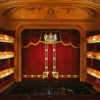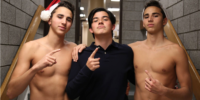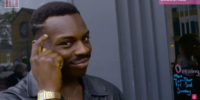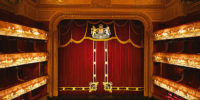 Boys’ Swim Team To Wear Little Santa Hats With Speedos
Boys’ Swim Team To Wear Little Santa Hats With Speedos  AP Art History to Incorporate Memes Into Curriculum
AP Art History to Incorporate Memes Into Curriculum  Ms. Kegel Writes, Stages, and Performs ‘One-Woman Opera’
Ms. Kegel Writes, Stages, and Performs ‘One-Woman Opera’  5 Awesome Virtual Backgrounds for Your Next Zoom Sesh
5 Awesome Virtual Backgrounds for Your Next Zoom Sesh  KEC Reduces Carbon Emissions by Replacing All Shuttles with Eight-Seat Tandem Bikes
KEC Reduces Carbon Emissions by Replacing All Shuttles with Eight-Seat Tandem Bikes 
As of last week, the College Board has decided to test students’ knowledge of memes on the AP Art History Exam in 2018. The material will constitute approximately one third of the test. In an official statement, Dr. Reginald Smartipance of the College Board announced, “The meme is a quintessential part of society, dating as far back as humanity itself. We felt that it needed to be included to truly incorporate art into the course. In the same way we can see the trends of history through art, memes evolve with culture; thus, every era is epitomized by its memes. The goal of studying memes is to better understand both the modern and postmodern aspects of today as they evolve in real time—a valuable skill for art and meme historians in any discipline.”
According to the course’s new proposed syllabus, the term “meme” comes from the Ancient Greek word “mimema,” which roughly translates to the modern-day “” Basic memes were developed as early as the Neolithic period, with cave paintings depicting funny scenes complete with precursor glyphs to the and emojis. This popular art form remained with early humans as they established civilizations, often developing to complex and sometimes controversial levels; for example, the Peloponnesian War was fought when both Athens and Sparta, two Ancient Greek city-states, claimed authorship of the same meme. As a result of the bloodshed in these wars, memes were declared illegal, becoming shrouded in secrecy for ages.
Great artists like DaVinci, Van Gogh, and Picasso all painted memes but refused to release them in fear that they would be connected to poverty and the occult. The real revival of the meme came about with the Internet, which allowed them to be generated, shared, and viewed by all under the protection of anonymity. Now, in 2017, the ancient stigma of memes has vanished, and the meme has become an integral viewport into the human soul and psyche, necessitating its inclusion into the AP Art curriculum. To keep up with the ever-changing AP Exam, Choate acted quickly to restructure and adapt its AP Art History curriculum for next year’s exams.
Even as the school moves away from AP Exams and AP Testing as a whole, Art History teachers lobbied to keep the course intact, arguing, “Memes are a vital part of our arts program and are only present in this course; it is of utmost importance that this AP class be preserved.” To reinforce its curriculum, Choate brought in some of the most renowned meme-creators from the depths of social media websites Facebook, iFunny, Twitter, and 4chan. Their first action was to rebrand the course as AP Art History & Memes 2: Electric Boogaloo. In an exclusive interview, one of the hired meme consultants, an iFunny artist by the name of “deklord000000000000001” revealed some facets of the new curriculum.
“Personally,” he stated, “I was hired for my expertise in spicy, postmodern memes. We have included lessons not only on some of this era’s great memes, like Dat Boi, Whomst’ve’d’en’ll, and, of course, the normie Harambe, but also on some of the more abstract memes that have been created during this period, which many of us experts in the meme community like to dub ‘meta.’” There is also an entire unit dedicated to New York memes, with a subunit on the word “deadass” and the Timberland style of boots commonly referred to as ‘Timbs.’ In addition to more modern memes, many more classical pieces and styles are to be included, such as the traditional ‘stock photo text’ works like those of Bad Luck Brian, Fry Squinty Eye, Kanye West Interruption, and other ‘demotivational posters’ dating as far back as 2006. This is believed to round out the course and give more examples of how previous styles have influenced modern meme artists. As one Art History teacher stated, “It’s interesting to track the course of memes throughout time.
In addition to studying memes, our comprehensive course will draw connections between memes of different periods, like comparing the neoclassicism of, perhaps, the Philosoraptor piece, to the more constructive postmodern abstract minimalism of the recent Trolley Meme phenomenon.” The course does not end with .jpg and .png formats, however, as alternative meme formats such as .mp4 videos of .gif animations along the lines of Charlie Sheen Winning and Keyboard Cat will receive individual study as well, providing a truly interdisciplinary dimension to the course. In preparation for the “Spicy OG Content” portion of the exam, students will also receive guidance on creating memes of their own, to be graded, as one teacher put, on, “relevance, humor, and overall zest.” Following these changes, the course is ultimately expected to become much more rigorous, and teachers and students alike agree that the course has no room for “weak memes.”
Many students are excited about the newly revamped course. James Rose ’18, for example, who had not initially intended to take Art History at Choate, expressed his enthusiasm, “I truly believe this course will both aid students in understanding the collective consciousness of our time as well as up the Choate meme game as a whole. I’m expecting to see my Facebook feed get a whole lot spicier.” The class is currently overenrolled by 300 students, and sources say there will be a highly selective application process to allow students equal opportunity to take this in-demand course. The first question on the application? “There is a trolley barreling down the railroad tracks…do you pull the lever?”
 Boys’ Swim Team To Wear Little Santa Hats With Speedos
Boys’ Swim Team To Wear Little Santa Hats With Speedos  AP Art History to Incorporate Memes Into Curriculum
AP Art History to Incorporate Memes Into Curriculum  Ms. Kegel Writes, Stages, and Performs ‘One-Woman Opera’
Ms. Kegel Writes, Stages, and Performs ‘One-Woman Opera’  5 Awesome Virtual Backgrounds for Your Next Zoom Sesh
5 Awesome Virtual Backgrounds for Your Next Zoom Sesh  KEC Reduces Carbon Emissions by Replacing All Shuttles with Eight-Seat Tandem Bikes
KEC Reduces Carbon Emissions by Replacing All Shuttles with Eight-Seat Tandem Bikes